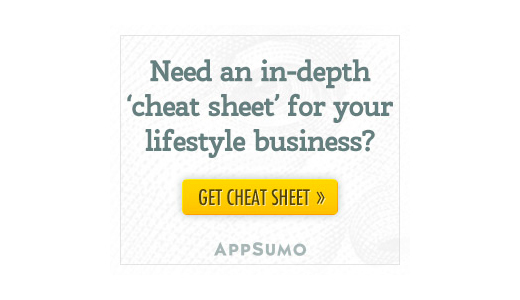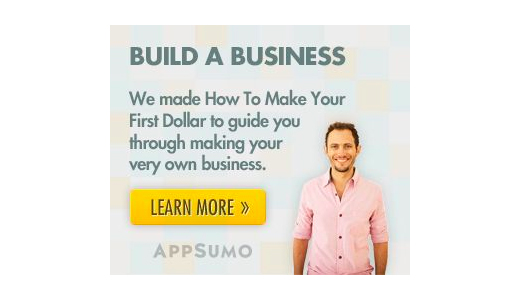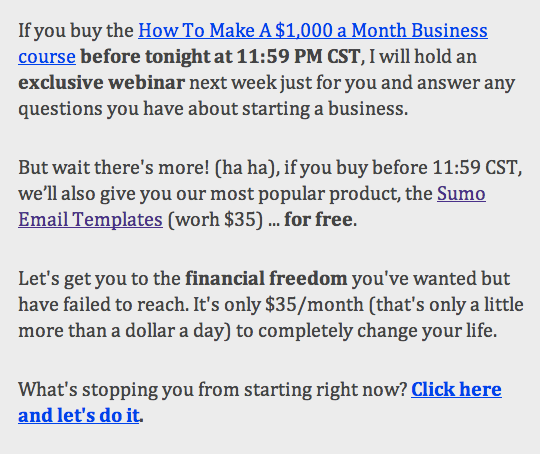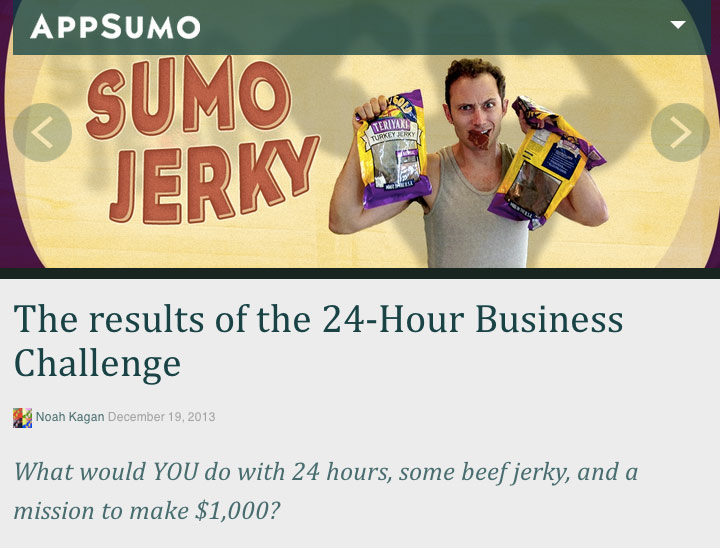AppSumo is a free newsletter that promotes tools/knowledge to help startups become winners. We’ve promoted awesome products (such as Optimizely, LinkedIn, and MailChimp) at special prices.
Our average selling price is around $49, which, for many small businesses and freelancers, is an impulse buy.
When we started selling a $300 digital product, I thought people would buy our product instantly. Unfortunately, this wasn’t the case at AppSumo when we released “How to Make a $1,000-a-Month Business” course.
I honestly thought we would promote the course to our mailing list of 650,000+ Sumo-lings, and we would reach our goal of 3,333 sales within a week. But our first promotion sold less than 100.
The shocking thing we learned from promoting this product is the process people use to make purchasing decisions on higher-priced items.
Think about going out to lunch. When you’re at the restaurant, buying, basically, is an impulse decision. As long as the price is within reason, it’s not really a big deal. You’ll buy something instead of leaving.
But we discovered that, if you’re selling a product for $300, it’s not an immediate buy for your customers. Bummer!
So, what does this mean for businesses?
You have to spend more time understanding the buying patterns of your buyers, and you have to know the hurdles and hesitations people must overcome before buying your product.
Here are the key things we learned that will help you sell a higher-priced digital product (SaaS, eBook, software, educational course, etc.):
1. Understand the Reason for Buying.
After you email your potential customers to buy:
A) For the people who buy, email or call them in order to understand why they bought. (Ask: “what was the main reason you made this purchase today?”)
Tip: You can use Qualaroo to get survey feedback instantly while people are on your site.
This will help you focus on the key attributes needed for your website and the actual language your customers are using.
It also will help you flesh out a customer avatar. For us, we found it was someone who has tried to start a business without success, isn’t looking for an overnight get-rich quick scheme, and wants a support system for when times get tough.
B) For the people who clicked to check out the product but didn’t buy, email them to investigate further.
This will produce a gold mine of information. You will get to personally respond to rejections, determine whether the reasons for the rejections are valid (or if the people are just misinformed), and uncover requests that aren’t being addressed by your current offering.
I’ve written about this and shared the exact survey we used here.
2. Patience.
Just knowing that the sales cycle is longer for higher-priced products was a mind-shift vs. expecting same-day purchases. Compare the date of a customer’s first visit with the date of buying in your database to guide you. We observed that the interval often is more than 4 days for us. So the time when you start marketing and educating your customers, generally is significantly before they finally buy.
3. Marketing Touches.
If you don’t have a lead scoring system like Marketo or HubSpot, try to look at the previous interactions of the person before they bought (or just ask them via email/phone). We found it took people between 3-5 experiences with us before buying. They watched a YouTube video, downloaded a white paper, received a few emails, or read my personal site OkDork.com before they felt comfortable enough to pull the trigger.
4. Customer Personas.
I discussed this above, but you really need to get as narrow as possible when you have a higher price. It’s about who will value your service/product and whether they have the money to purchase it. Our best customers are people who were already working crappy/corporate jobs, like Tim Ferriss. They wanted freedom with a side income they could possibly transition to in the future. Once you know this, it makes it much easier to find these people.
5. Retargeting.
We use Perfect Audience. This is a no brainer. For example, in the past 7 days, we’ve spent $638.13 and have made $995 (not including recurring revenue). In our business, it has been more effective to get people to go to our site and retarget them than to collect an email and throw them in an auto-responder sequence.
Here are a few of the ads:
It’s key to make sure you include Facebook ads and newsfeed targeting in addition to the web. We saw Facebook right column ads and web retargeting work the most effectively for us.
Also, it’s okay to show your retargeted ads to current customers. Limit your retargeting to the last 30 days of visitors. Recent customers will feel reinforced about the product they just purchased.
6. Time Limitations.
A few times we tested adding live webcasts with me or other products as a bonus for buying within a certain period of time. This worked well. Be careful not to abuse this, though, as previous customers will be annoyed if you promise them an exclusive thing but continually give it away.
Here’s the image we used:
7. Seeing is Believing.
Our BEST method of selling ever was showing me starting a Sumo Jerky business and making $1,000 profit within 24 hours. Since testimonials sometimes can seem like lies, show exactly what results potential customers can expect from your product by proving it.
8. Live Chat.
This is one of the best sales tools we have. In a physical store, the proprietor can listen and answer any customer question. Online it’s much harder. You can use Olark or SnapEngage. If you’re busy, you can just put this on your buy page. I’ve found this valuable for 3 specific reasons:
- You can add the questions people keep asking to your website FAQs.
- Chatting with customers leads to higher conversion rates than people browsing and purchasing on their own.
- People have more trust in your business if they get to interact with a real human.
9. Live Webinars.
This is like the modern infomercial. It’s not my favorite thing, but people have tons of questions, and we were able to address them via this medium. We did it via Google Hangout so it would be indexed and anyone could watch in the future. You also can try using Livestream.
10. Follow Up.
Many customers said they didn’t feel completely ready for our product before joining. So we said we would personally follow up with them, and we did. We utilized followup.cc to help with that. By the way, it also helps when you care and have a product that you’re proud of.
11. Test your messaging.
We originally called the course “How to Make your First Dollar” and tested a few variations. It turned out that “How to Make a $1,000-a-Month Business” increased overall conversions by 8%.
12. Customer Success.
This is obvious, but the more successful you make your customers, the better your marketing will be. Really invest the time to help your current customers as much as possible. They are your best sales people and give great referrals.
Tip: Check out the guys at Intercom.io and how they promote their customers
13. Make your contact info as accessible as possible.
Heck, my phone number is on our landing page. If people are going to spend money with you, let them get hold of you as easily as possible. Also, this is a great way to learn the language your customers use and the hesitations they have about buying.
Selling a high-priced item takes time, patience, and, ultimately, a successful product that creates real value for your customers.
About Noah Kagan: He was #30 at Facebook (product manager), #4 at Mint (Director of Marketing), and now is the Chief Sumo at AppSumo.com.





Comments (18)